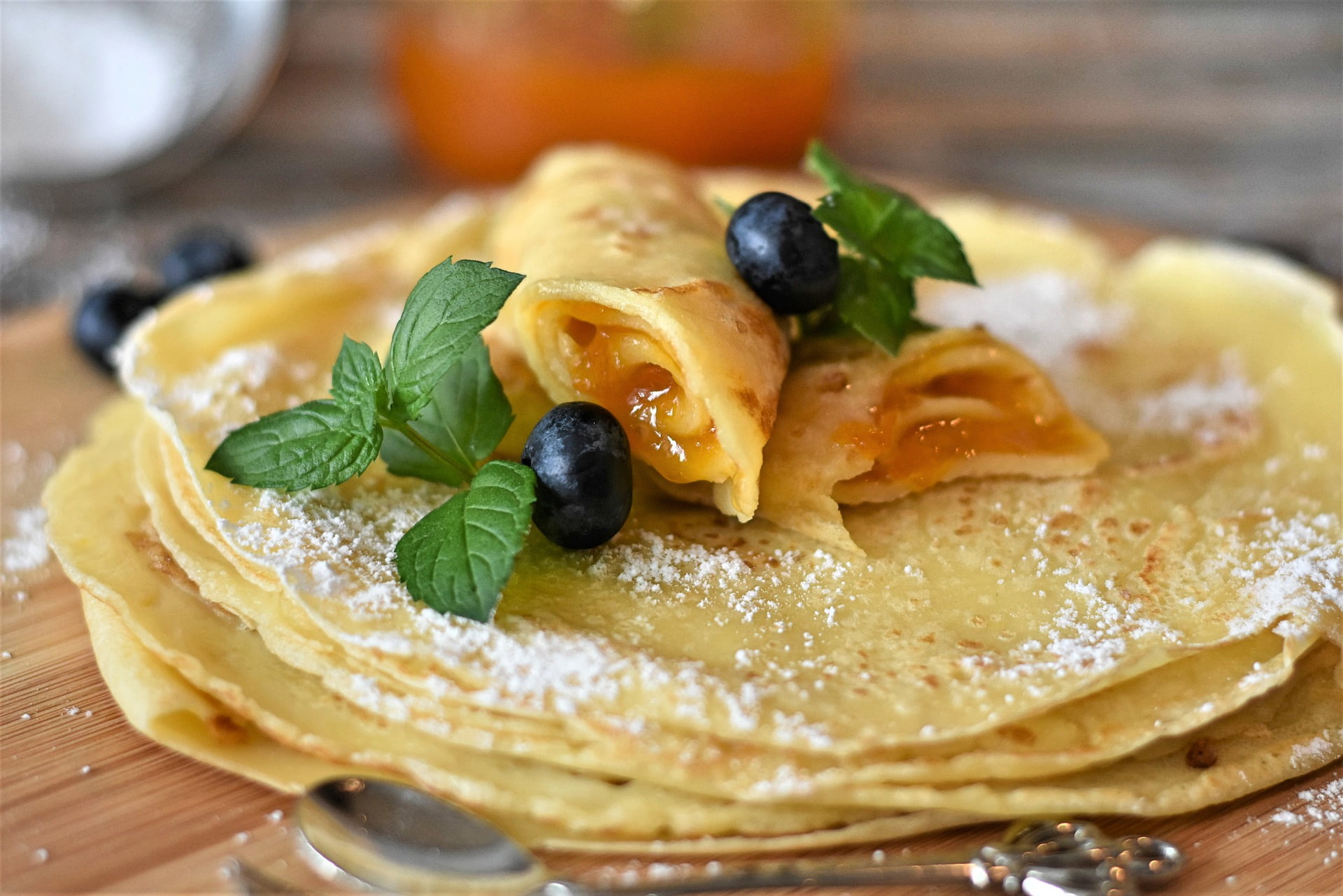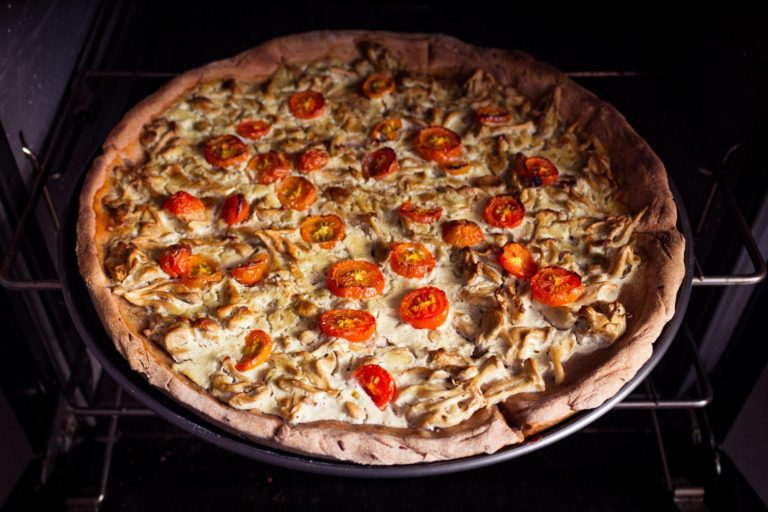How to make Crepes
A Culinary Adventure in Elegance and Flavor
Jump to RecipeWhen it comes to culinary elegance and versatile flavor canvases, crepes reign supreme. These delectable, thin creations have transcended borders and cultures, offering a platform for both sweet indulgence and savory artistry. As we delve into the world of crepes, we’ll journey through their origins, explore the art of crafting the perfect crepe, and savor the diverse and creative interpretations that span the globe.
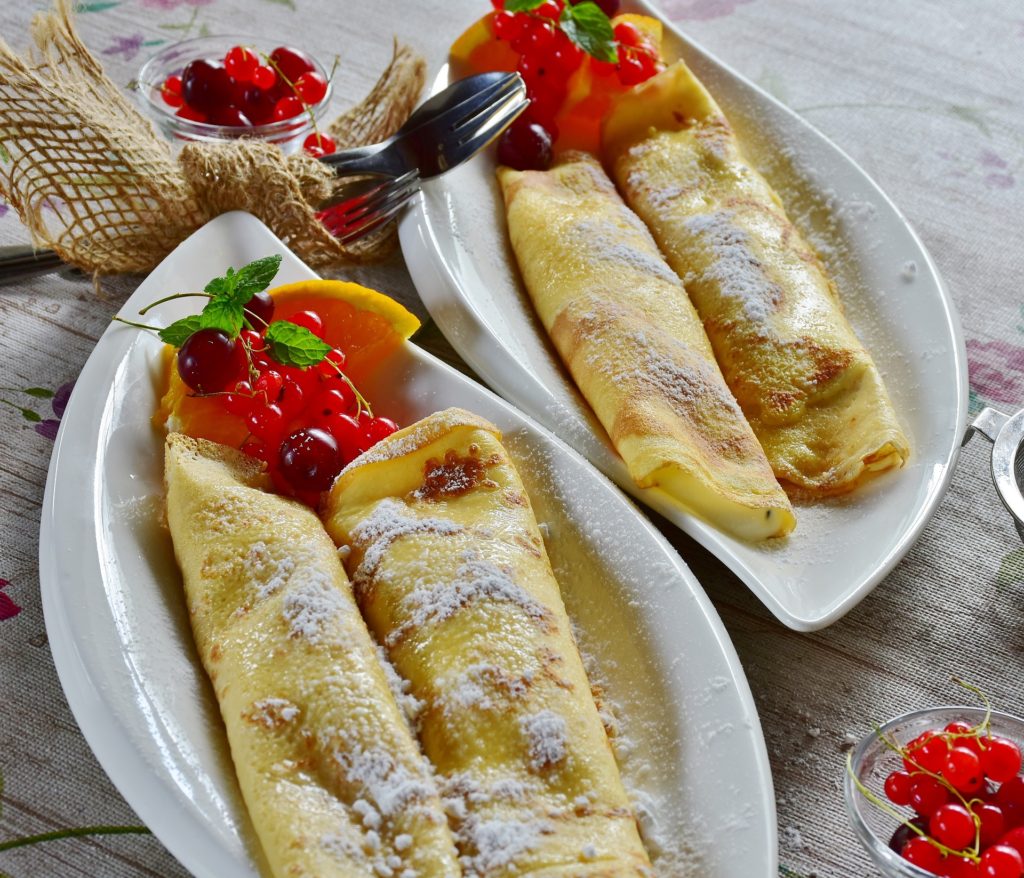
Unraveling the Origin
“Not the same as pancakes“, Crepes, with their delicate appearance and delightful taste, holds a rich history that dates back centuries. Originating in Brittany, France, these paper-thin treats were initially known as “galettes.” Over time, they evolved, transforming into the beloved crepes we savor today.
While France remains the heartland of crepe culture, these delectable creations have transcended their origins. From the bustling streets of Paris to the food trucks of Tokyo, crepes have found a home in the hearts and palates of people worldwide.
The Art of Crafting Crepes
Ingredients that Make Magic Creating the perfect crepe begins with quality ingredients. A blend of flour, eggs, milk, and a hint of butter forms the foundation of a velvety batter. The precise proportions and careful selection of ingredients contribute to the crepe’s final texture and flavor.
The Perfect Crepe Batter Consistency Achieving the right consistency for your crepe batter is an art in itself. A batter that resembles heavy cream ensures that the mixture spreads thinly and evenly across the cooking surface, resulting in that signature delicacy.
Tools of the Trade: Crepe-making Essentials Arming yourself with the right tools can make the crepe-making process smoother. A non-stick skillet or crepe pan, a wooden spatula for delicate flipping, and a ladle for pouring the batter form the basic toolkit for any crepe enthusiast.
Basic Crepe-Making Process
Prepping Your Cooking Surface Before embarking on your crepe-making journey, ensure your cooking surface is well-prepared. Whether using a dedicated crepe pan or a non-stick skillet, a light coating of butter or oil prevents the batter from sticking.
The Sizzle and Swirl Technique Pouring a ladleful of batter onto the heated pan initiates the sizzle and swirl technique. By lifting the pan off the heat and tilting it in a circular motion, the batter evenly coats the surface, resulting in that telltale thinness.
Achieving that Coveted Thinness The key to a true crepe lies in its thinness. As the batter spreads across the pan, the result is a delicate, lacy creation that’s perfect for both folding and filling.
Intrigued to continue your crepe-making journey? Join us as we explore the realm of dessert crepes and their irresistible allure. Whether you’re a fan of classic Nutella and banana delights or crave the elegance of Crepe Suzette, the world of crepes offers endless opportunities for culinary exploration and indulgence.

Sweet Temptations: Dessert Crepes
Decadent Nutella-Banana Bliss
Indulgence takes a new form with the Nutella-Banana crepe. As the warm crepe embraces the creamy Nutella, its richness intermingles with the sweetness of ripe bananas. Each bite offers a symphony of textures and flavors that dance on your palate.
Strawberry Fields Forever: Cream-Filled Joy
For those seeking a burst of freshness, the strawberry cream crepe is a delightful choice. A medley of ripe strawberries nestled within a cloud of whipped cream finds its home in the thin embrace of the crepe. The balance of tartness and sweetness is a true testament to the crepe’s versatility.
The Artistry of Crepe Suzette
Elevating dessert crepes into an art form, the Crepe Suzette is a masterpiece of flavors. A combination of orange zest, Grand Marnier, and a touch of sugar creates a luscious sauce that envelops the crepe. A dash of theatrical flair is added as the crepe is flambéed, resulting in a dessert that’s as mesmerizing as it is delectable.
Stay tuned as we venture into the realm of savory crepes, where culinary creativity knows no bounds. From classic ham and cheese galettes to inventive spinach and feta combinations, the savory side of crepes is a playground for your taste buds.
Savoring Savory Creations
Classic Ham and Cheese Galette
A timeless favorite, the ham and cheese galette marries the saltiness of ham with the melty allure of cheese. Folded into the crepe’s delicate layers, this combination is a testament to how simple ingredients can create culinary wonders.
Spinach and Feta Stuffed Delight
Venturing into a healthier realm, the spinach and feta crepe is a nutritional powerhouse. The earthy notes of spinach blend harmoniously with the tangy richness of feta cheese, offering a balanced and satisfying flavor profile.
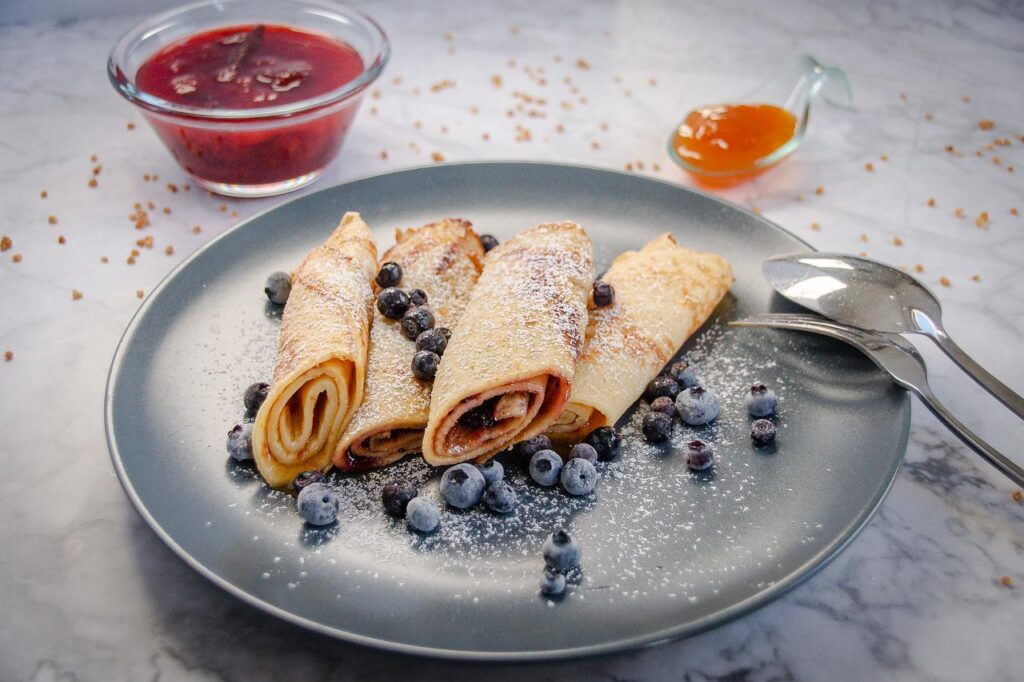
Mushroom Medley: Umami Galore
For those who revel in the savory embrace of umami, the mushroom medley crepe is a must-try. A mixture of sautéed mushrooms, herbs, and a sprinkle of Parmesan creates a symphony of flavors that awaken the senses with every bite.
But the world of crepes doesn’t stop at the traditional. In our next section, we’ll explore the gluten-free possibilities and venture into the realm of international fusion.
Gluten-Free and Beyond
Embracing Crepes for Gluten-Intolerant Foodies
For those with gluten sensitivities, the allure of crepes is not lost. By substituting traditional wheat flour with gluten-free alternatives, these paper-thin wonders become accessible to all, ensuring that everyone can partake in the culinary delight.
Exploring Alternative Flours: Buckwheat Brilliance
Buckwheat flour, with its nutty and robust flavor, offers a distinctive twist to crepe-making. Hailing from Brittany, the buckwheat crepe, also known as “galette de sarrasin,” embraces a range of savory fillings, creating a rustic and hearty gastronomic experience.
Join us as we embark on a journey of fusion and creativity, where crepes take on a global identity through innovative and unexpected pairings. From Japanese-inspired okonomiyaki crepes to Indian fusion delights, the culinary world knows no bounds when it comes to crepe interpretations.
Fusion Fun: International Crepe Twists
Japanese-Inspired Okonomiyaki Crepe
Marrying the flavors of Japan with the elegance of crepes, the okonomiyaki crepe offers a symphony of textures and tastes. A delicate crepe enfolds a harmonious blend of cabbage, seafood, mayonnaise, and okonomiyaki sauce. It’s a fusion dish that pays homage to tradition while embracing modernity.

Indian Fusion: Curry Crepes with a Kick
Spices dance in a celebration of flavors in the curry crepe. Drawing inspiration from Indian cuisine, this creation introduces curry-infused fillings paired with chutneys, yogurt, and fresh herbs. It’s a sensory explosion that combines cultures on a single plate.
Latin Flair: Crepes with a Picadillo Punch
Bringing the vibrancy of Latin cuisine to the forefront, the picadillo crepe is a carnival of flavors. Ground meat, olives, raisins, and spices intertwine within the crepe’s tender embrace, offering a balance of savory and sweet that’s characteristic of Latin cuisine.
Curious to learn the art of folding and garnishing crepes with finesse? Our next section will delve into the various folding techniques that elevate these delicate creations into visual and culinary masterpieces.
A Gastronomic Canvas: Creative Folding Techniques
The Classic Roll: Simple and Elegant
The classic roll fold is the foundation of crepe folding techniques. The crepe is delicately folded into a cylindrical shape, encasing the fillings within. This technique is the canvas for both sweet and savory crepes, allowing the ingredients to shine.
Enveloping Fillings with the Burrito Fold
Emulating the embrace of a burrito, the burrito fold technique encases the fillings within a rectangular pocket. This method is perfect for containing generous portions of ingredients, ensuring that every bite is a flavorful explosion.
Intricate Pleats of the Fan Fold
For an artistic presentation, the fan fold technique is a showstopper. The crepe is meticulously folded in an accordion-like manner, creating a visual delight reminiscent of an elegant fan. This technique not only enhances the aesthetics but also allows for precise portion control.
The journey into the world of crepes continues as we explore the myriad garnishes and accompaniments that elevate these delicate creations. From whipped cream peaks to exotic chutneys, the options are as diverse as they are tantalizing.
Garnishes and Accompaniments
Whipped Cream Peaks and Dustings of Cocoa
Adding a touch of indulgence, whipped cream peaks atop a crepe are a visual delight. A sprinkling of cocoa powder or a drizzle of chocolate sauce adds a rich and luxurious finish that’s both inviting and satisfying.
Fruits as Fresh as Morning Dew
The vibrancy of fresh fruits complements the delicate crepe beautifully. Whether it’s a medley of berries, slices of kiwi, or the sweetness of mango, the addition of fruits adds a burst of freshness that enhances the overall experience.
The Intrigue of Crème Fraîche and Chutneys
Elevating your crepe creation with a dollop of crème fraîche offers a creamy and tangy contrast. Alternatively, exploring the world of chutneys and savory sauces introduces a harmonious blend of flavors that can transform a simple crepe into a gastronomic masterpiece.
But crepe-making is more than just a culinary endeavor; it’s an art form that allows individuals to express their creativity and explore a world of flavors. Join us as we delve into the artistic aspects of crepe cuisine and explore the ways in which crepes have influenced art and design.
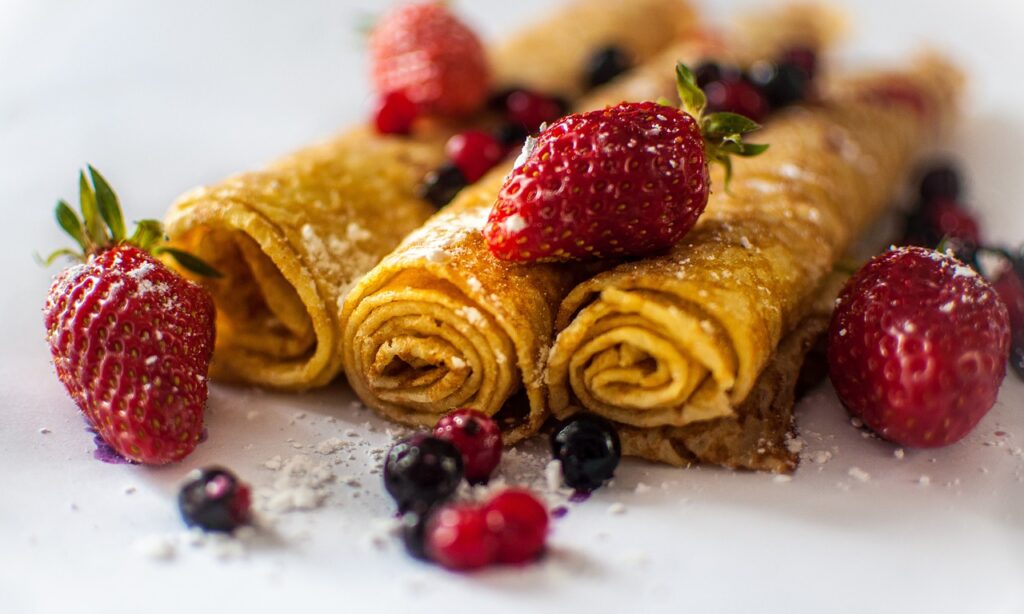
Crepe-Making as an Art
From Home Cooks to Culinary Artists
The beauty of crepe-making lies in its accessibility. From home kitchens to professional restaurants, individuals of all skill levels can partake in this culinary artistry. The process of crafting, filling, and presenting crepes offers a canvas for self-expression and creativity, making each crepe a unique masterpiece.
The Joy of Customizing Fillings and Presentations
Just as an artist selects colors and strokes to create a painting, crepe enthusiasts have the freedom to select fillings and create presentations that reflect their tastes and personalities. Whether you prefer classic combinations or daring flavor experiments, crepes offer a playground for your culinary imagination.
Hosting a Crepe Party
DIY Crepe Stations: Interactive Culinary Fun
Transform any gathering into a culinary affair with a DIY crepe station. Lay out an array of fillings, sauces, and toppings, allowing guests to personalize their crepe creations. This interactive experience fosters camaraderie and offers a unique twist to traditional party catering.
Crepe Toppings Galore: A Flavor Extravaganza
From sweet to savory, the assortment of crepe toppings is as diverse as the crepe itself. Consider offering a variety of options such as fresh fruits, assorted cheeses, nuts, herbs, and even proteins like grilled chicken or smoked salmon. This abundance ensures that every guest’s palate is catered to.
Perfecting the Flip: Tips and Tricks
Mastering the Tricky Flip with Finesse
The flip is often considered the most challenging part of crepe-making. The key is to wait until the edges of the crepe are lightly golden before attempting the flip. A swift and confident motion, combined with the right utensils, will yield a seamless rotation.
Patience and Practice: The Flip’s Learning Curve
Just as in any skill, mastering the perfect flip requires practice and patience. Don’t be discouraged by initial mishaps; instead, embrace each attempt as a learning opportunity. Before you know it, your flips will become as effortless as they are graceful.
Crepe Cuisine Around the World
Russian Blini: A Kin of Crepes
Drawing parallels to crepes, Russian blini are a beloved culinary tradition. These yeasted pancakes are slightly thicker but share the same spirit of versatility. Often served with caviar, sour cream, or jams, blini are a testament to how similar concepts can manifest in different cultures.
Italian Crespelle: Rolled Delicacies
In Italy, crepes take on the name “crespelle.” These thin wonders often find themselves filled with ricotta, spinach, and a touch of nutmeg before being rolled into delicate cylinders. The elegance of crespelle reflects the artistry that defines Italian cuisine.
Beyond the Plate: Crepe-Inspired Art and Design
Crepes as Muse: Culinary Artistry in Paintings
The allure of crepes extends beyond the plate, inspiring artists to capture their delicate beauty in paintings. The interplay of textures, the contrast of colors, and the element of surprise within each folded crepe have fueled the imaginations of painters throughout history.

Crepe Patterns and Textures in Fashion
The intricate folds of crepes have also inspired fashion designers, who have translated their textures and patterns into clothing. Crepe fabric, known for its distinct crinkled surface, has found its way into elegant dresses, blouses, and other garments, offering wearers a tactile and visual feast.
From Breakfast to Midnight Cravings
Rise and Shine with Breakfast Crepes
Begin your day on a high note with breakfast crepes that energize both body and spirit. Fill them with scrambled eggs, sautéed vegetables, or a blend of cheeses to create a satisfying morning meal that’s as nutritious as it is delicious.
Late-Night Indulgences: Crepes Under the Moon
Crepes also hold their charm after the sun sets. Late-night cravings are met with crepes that offer a symphony of flavors and textures. Whether it’s a chocolate-drizzled creation or a savory delight, crepes provide comfort and indulgence during those quiet, moonlit moments.
Healthier Indulgence: Nutritional Insights
The Balance of Flavor and Nutrition
While crepes are celebrated for their indulgent nature, they can also be part of a balanced diet. Opt for whole grain flours to increase the fiber content, and incorporate a variety of vegetables and lean proteins as fillings to enhance the nutritional value of your creations.
Incorporating Whole Grains for Added Benefits
Replacing refined flour with whole grains not only introduces a nuttier flavor but also boosts the nutritional profile of crepes. Buckwheat, whole wheat, and quinoa flours are excellent alternatives that add complexity to both the taste and texture of your crepes.
The Joy of Sharing: Passing Down Crepe Traditions
Family Recipes and Time-Honored Techniques
Crepes often hold a special place in family traditions. Passed down from generation to generation, these recipes encapsulate memories and stories that enrich the dining experience. The act of cooking and sharing crepes becomes a way to connect with one’s heritage and ancestors.
Building Culinary Memories Across Generations
Teaching younger generations the art of crepe-making is a heartfelt endeavor. The act of standing side by side, pouring batter onto a sizzling pan, and flipping with anticipation creates lasting memories that foster a sense of continuity and togetherness.
Exploring Exotic Fillings and Flavors
Seafood Sensations: Shrimp and Scallop Crepes
Elevate your crepe experience with an oceanic touch. Delicate shrimp and succulent scallops, gently cooked and paired with fragrant herbs, create a symphony of flavors that transport you to coastal havens.

Exquisite Experiments with Exotic Spices
Delve into the world of spices and ignite your taste buds with exotic crepe fillings. A fusion of spices like saffron, cardamom, or sumac can transform the ordinary into the extraordinary, offering a sensory journey that captivates and surprises.
Embrace the Crepe Adventure
A Culinary Voyage of Endless Exploration
Crepes, with their thin and delicate nature, open doors to a world of culinary exploration. From their humble origins in France to their global interpretations, these versatile creations inspire creativity, self-expression, and a sense of adventure in the kitchen.
From Novice to Connoisseur: Your Crepe Journey
Whether you’re a novice home cook or a seasoned culinary connoisseur, the journey of crepe-making is one that rewards both the senses and the soul. With each flip, fold, and filling, you create not just a meal, but a symphony of flavors that brings joy to your palate and those of the lucky ones who share in your creations.
So, there you have it, a comprehensive guide to the art of crepe-making. From mastering the perfect batter consistency to exploring international twists and embracing culinary artistry, crepes offer a universe of possibilities. As you embark on your own crepe-making journey, remember that the canvas is yours to paint, and the flavors are yours to compose. Happy crepe-making!
Crepes Recipe Ingredients: Crafting Elegance on a Plate
From the charming streets of Paris to the comfort of our own kitchens, crepes have woven themselves into the fabric of culinary culture. These delicate, paper-thin wonders boast a versatility that spans the spectrum from sweet to savory, making them a canvas for culinary artistry. In this guide, we’ll delve into the core ingredients that bring crepe magic to life and explore the nuances that elevate these creations from mere recipes to unforgettable experiences.
Crepes Recipe Ingredients: Crafting Elegance on a Plate
From the charming streets of Paris to the comfort of our own kitchens, crepes have woven themselves into the fabric of culinary culture. These delicate, paper-thin wonders boast a versatility that spans the spectrum from sweet to savory, making them a canvas for culinary artistry. In this guide, we’ll delve into the core ingredients that bring crepe magic to life and explore the nuances that elevate these creations from mere recipes to unforgettable experiences.

Essential Ingredients for Crepes
Flour: The Foundation of Elegance
At the heart of every crepe lies the flour, a fundamental ingredient that dictates its texture and character. While all-purpose flour is the traditional choice, you can venture into nuttier flavors with buckwheat flour or embrace healthfulness with whole-wheat alternatives.
Eggs: The Binder of Flavors
Eggs play a pivotal role in crepe-making, acting as the binding agent that brings the batter together. Beyond their structural contribution, eggs lend a rich and subtle flavor that complements both sweet and savory fillings.
Milk: The Liquid Elegance
Milk introduces liquid elegance to the crepe batter, creating a delicate consistency that spreads smoothly across the pan. Whether you opt for whole milk, almond milk, or another variety, the choice affects the crepe’s richness and overall flavor profile.
Butter: The Luscious Enricher
Melted butter adds a touch of lusciousness to the crepe batter, resulting in a tender and luxurious texture. Its integration infuses a subtle richness that tantalizes the palate with every bite.
Choosing the Right Flour
All-Purpose Flour: The Versatile Standard
The staple choice for crepe aficionados, all-purpose flour provides a neutral canvas that lets other ingredients shine. Its mellow taste and fine texture contribute to the classic crepe experience.
Buckwheat Flour: The Nutty Alternative
For those craving a nuttier, heartier flavor, buckwheat flour steps onto the stage. Originating in Brittany, buckwheat crepes, known as galettes, offer a distinct earthiness that pairs wonderfully with savory fillings.
Whole Wheat Flour: The Nutrient-Boosting Option
Elevate the nutritional profile of your crepes by incorporating whole wheat flour. Its inherent nuttiness and higher fiber content add a wholesome dimension, making your crepes not only delicious but also more satisfying.
Gluten-Free Flour: The Inclusive Alternative
Inclusive dining experiences call for gluten-free flour alternatives. Explore rice flour, almond flour, or a gluten-free baking mix to ensure that everyone can enjoy the delicate joy of crepes without dietary restrictions.
Eggs: Binding Flavors Together
The Egg’s Culinary Role
Eggs act as culinary conductors, orchestrating the harmony of ingredients in crepe batter. Their binding properties ensure that the batter transforms into a cohesive, silky mixture that spreads evenly across the pan.

Creating a Harmonious Texture
Beyond their functional role, eggs contribute to the desired texture of crepes. The proteins in eggs coagulate upon cooking, giving crepes their delicate structure and a tender, yet slightly resilient, bite.
Milk Matters
Milk Varieties: From Whole to Plant-Based
The choice of milk is a canvas upon which to paint the flavor palette of your crepes. Whole milk offers richness, while skim milk imparts lightness. For those opting for plant-based alternatives like almond, soy, or oat milk, the resulting crepes maintain a similar texture and an added layer of flavor complexity.
Achieving Perfect Consistency
The quantity of milk you use plays a significant role in the consistency of your batter. The balance between liquid and dry ingredients determines whether your batter spreads into the thin, delicate crepe you envision.
The Role of Salt
Salt’s Subtle Influence on Flavor
Salt operates behind the scenes in crepe-making, enhancing flavors in subtle ways. It counters excessive sweetness in dessert crepes, allowing the nuances of fillings to shine, and in savory crepes, it accentuates the ingredients’ savory notes.
Balancing Sweet and Savory Crepes
The amount of salt used should be tailored to the type of crepe you’re creating. For sweet crepes, a touch of salt keeps the flavors grounded, preventing overwhelming sweetness. In savory crepes, salt amplifies the umami profiles of fillings like cheese, vegetables, and meats.
The Butter Touch
Incorporating Melted Butter
Melted butter introduces a luxurious quality to crepe batter. As it’s incorporated, it intertwines with the other ingredients, ensuring that each crepe carries a hint of buttery richness.
Infusing Richness and Depth
The role of butter extends beyond its textural contributions. It imparts a subtle richness that lingers on the palate, enhancing the overall flavor profile of the crepes.
Optional Flavor Enhancers
Vanilla Extract: A Subtle Sweet Note
For those embracing the world of sweet crepes, a dash of vanilla extract introduces a delicate aromatic note. Its presence is subtle, enhancing the overall flavor experience without overwhelming it.

Sugar: Adjusting Sweetness Levels
Customizing the sweetness of your crepes becomes an art with the incorporation of sugar. Depending on your palate and the desired flavor balance, you can fine-tune the amount of sugar in the batter. A delicate touch of sweetness can enhance the overall enjoyment of dessert crepes, harmonizing with the flavors of the fillings.
Sumptuous Fillings and Toppings
Fruits: Freshness and Vibrancy
Elevate your crepe experience with the vibrant allure of fresh fruits. From the succulent juiciness of strawberries to the tropical sweetness of pineapple, fruits introduce bursts of freshness that complement the delicate crepe texture. Their natural flavors add a dynamic layer to the overall taste profile.
Nutella and Chocolate: Decadence Defined
Indulge your senses with the decadence of Nutella and chocolate. The velvety hazelnut spread intertwined with the rich allure of chocolate creates a symphony of flavors that defines luxury. Drizzled, spread, or gently folded into the crepe, this combination satisfies cravings with its irresistible richness.
Savory Fillings: An Array of Options
In the realm of savory crepes, the world is your oyster. Explore a diverse array of fillings, from the classic pairing of ham and cheese to the sophistication of smoked salmon and cream cheese. The crepe’s delicate embrace acts as the perfect vehicle for savory ingredients, allowing their complexities to shine.
Embracing Creativity in Crepe Cuisine
Experimentation and Innovation
Venture beyond the ordinary and immerse yourself in the realm of experimentation. Crepe cuisine welcomes innovation, encouraging you to blend unexpected flavors and textures. Allow your culinary imagination to take flight, crafting crepes that defy conventions and introduce a touch of avant-garde artistry to your plate.

Personalizing Your Crepe Experience
The true beauty of crepes lies in their versatility and the personal touch you bring to each creation. From the choice of flour to the selection of fillings and toppings, you have the power to tailor your crepe experience to your individual preferences. This personalization transforms each crepe into an extension of your culinary identity, reflecting your tastes and creativity.
As you embark on your crepe-making journey, armed with the knowledge of these essential ingredients and their roles, remember that crepes are more than just a dish—they’re an artistic expression. Flour, eggs, milk, salt, and butter come together in a harmonious dance, guided by your vision and creativity. With every delicate fold and savory or sweet bite, you’re crafting a culinary masterpiece that delights the senses and invites you to explore the endless possibilities of crepe cuisine.
Directions
- Prepare the Batter:
In a mixing bowl, whisk together the flour and salt. In a separate bowl, beat the eggs and then add them to the flour mixture. Gradually add the milk while whisking to create a smooth batter. Finally, pour in the melted butter and mix until well combined.
2. Rest the Batter:
Allow the batter to rest for about 15-30 minutes. This resting period helps the flour fully absorb the liquid and results in a better crepe texture.
3. Heat the Pan:
Place a non-stick skillet or crepe pan over medium heat. You can lightly grease the pan with a small amount of butter or oil using a paper towel to prevent sticking.
4. Pour the Batter:
Give the batter a quick stir before using it. For each crepe, pour a small ladleful (about 1/4 cup) of batter into the center of the hot pan.
5. Swirl and Cook:
Quickly lift the pan off the heat and tilt it in a circular motion, allowing the batter to spread and coat the bottom of the pan in a thin layer. Place the pan back on the heat and cook the crepe for about 1-2 minutes, or until the edges start to lift and the bottom is lightly golden.
6. Flip and Finish Cooking:
Gently loosen the edges of the crepe with a spatula. Once the crepe is cooked on one side, carefully flip it using the spatula or your fingers and cook the other side for an additional 1-2 minutes, until both sides are golden.
7. Remove and Repeat:
Slide the cooked crepe onto a plate. You can stack the crepes on top of each other as you cook the rest, placing a piece of parchment paper or wax paper between them to prevent sticking.
8. Fill and Fold:
Fill the crepes with your desired sweet or savory fillings. Common options include fresh fruits, whipped cream, chocolate, cheese, vegetables, and meats. Fold or roll the crepe to encase the fillings.
9. Garnish and Serve:
Garnish your crepes with powdered sugar, drizzles of syrup, a dollop of whipped cream, or any other topping you prefer. Serve the crepes warm and enjoy!
Remember, crepe-making is a skill that improves with practice. Don’t be discouraged if your first few crepes aren’t perfect; each attempt will bring you closer to mastering the art of creating thin, delicate, and delicious crepes. Enjoy your culinary adventure!
How to make Crepes
Course: Breads10 – 12
servings25
minutes20
minutes95
kcalIngredients
1 cup all-purpose flour (plain flour)
2 large eggs
1 1/4 cups milk (whole milk or any milk of your preference)
1/4 teaspoon salt
2 tablespoons unsalted butter, melted
Optional: 1 tablespoon sugar or sweetener (for sweet crepes)
Directions
- Whisk flour, salt. Beat eggs, add to flour. Gradually add milk, whisk. Add melted butter, mix
- Rest batter for 15-30 minutes
- Heat non-stick pan, lightly grease with butter/oil.
- Pour 1/4 cup batter, swirl to coat pan.
- Cook 1-2 mins until edges lift and bottom is golden.
- Gently flip, cook 1-2 mins on other side.
- Slide crepe onto plate. Stack with parchment in between.
- Fill with desired ingredients, fold or roll.
- Garnish with toppings.
- Serve warm and enjoy!
Notes
- The calorie content of each crepe can vary based on factors like size and additional ingredients. On average, a plain crepe made from this recipe is estimated to have around 90-100 calories. Keep in mind that the calorie count will increase if you add fillings such as Nutella, whipped cream, or cheese.

